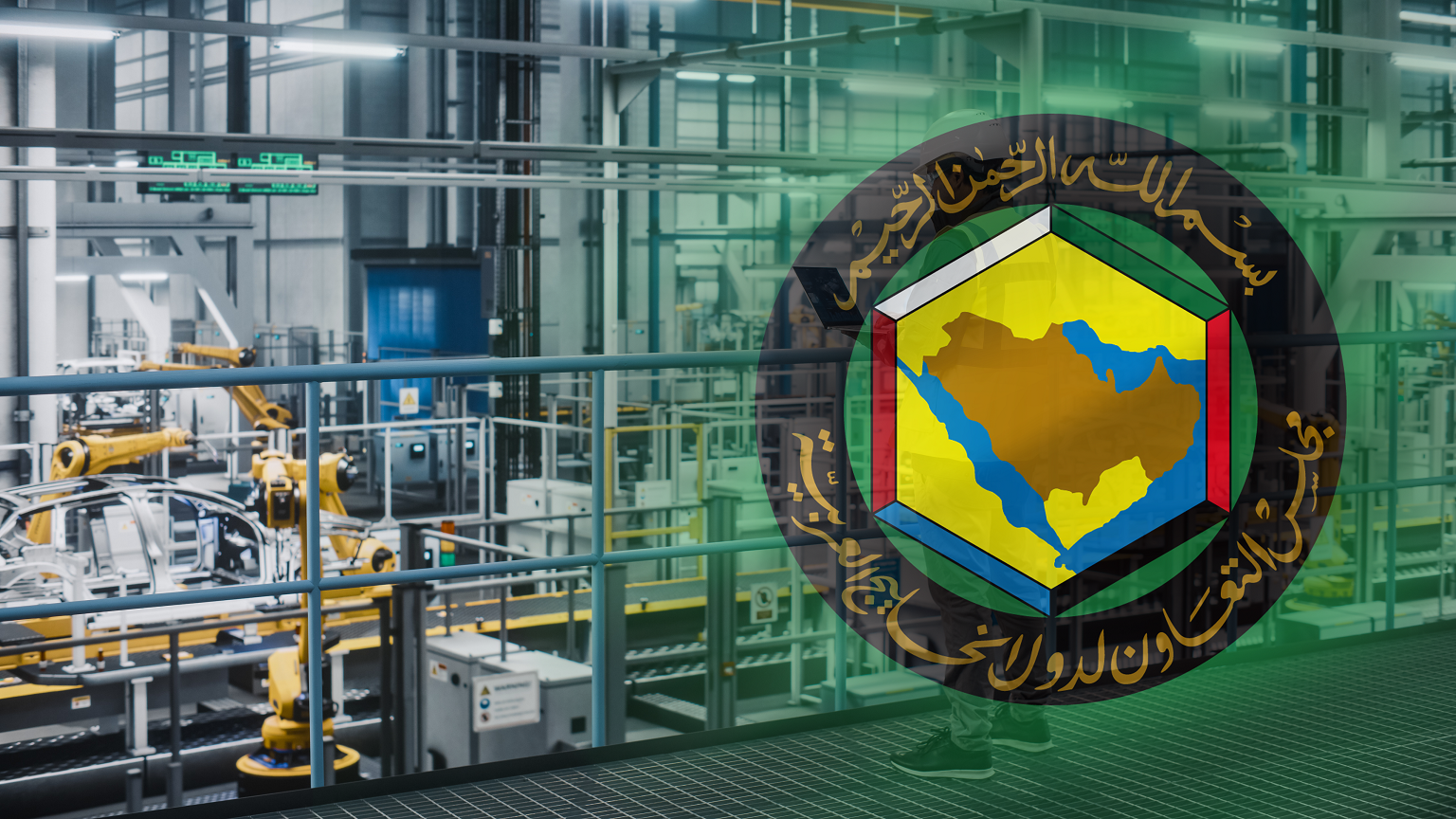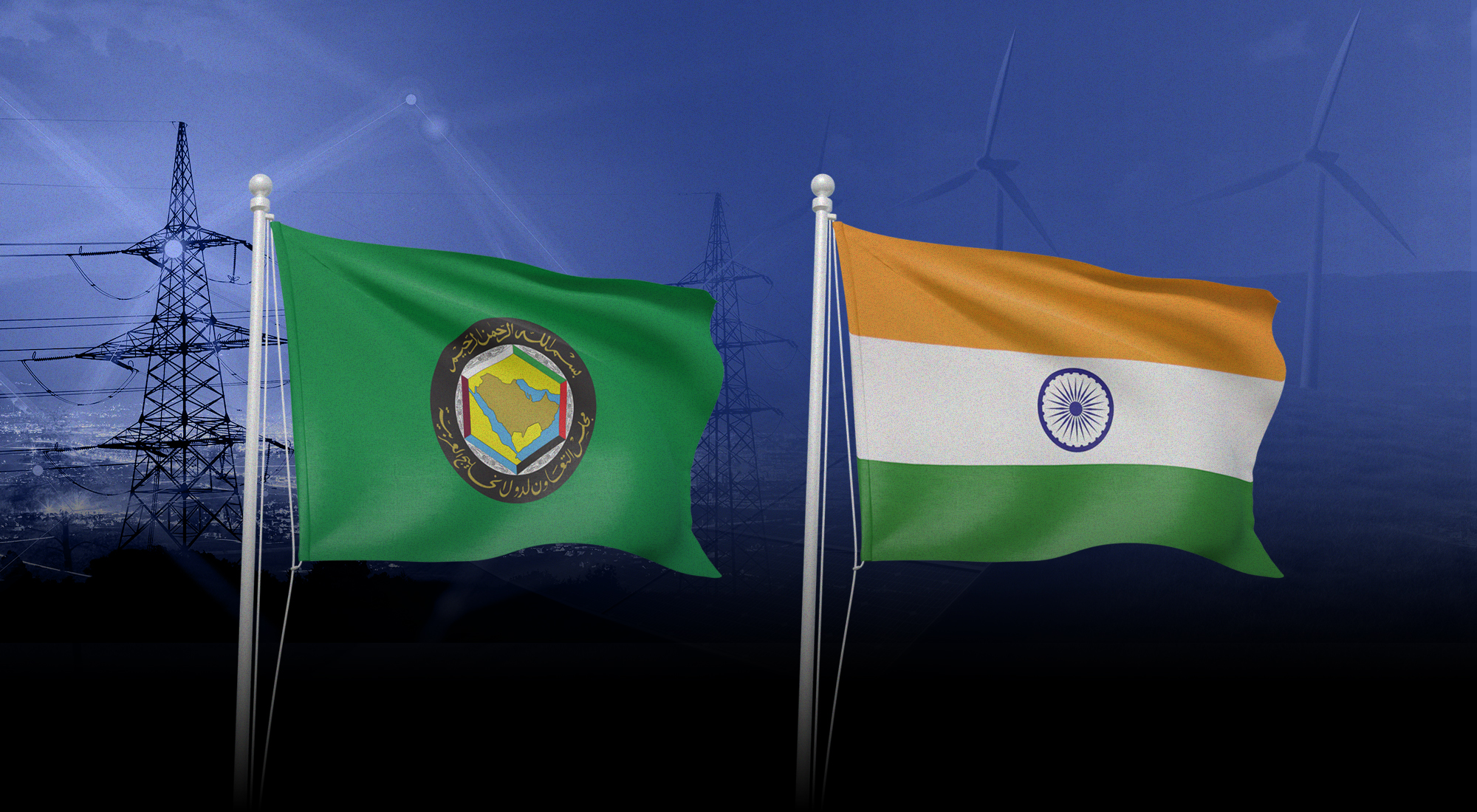Introduction
The manufacturing sector has long been of key importance to countries’ economic sustainability and competitiveness, and is a key contributor to the global economy, amounting to 16.5% of global GDP in 2020.[1] Beyond economic growth, an efficient manufacturing base is strategically important to national development. Characterized by its highly interdependent relationship with infrastructure, supply chains, logistics networks, and labor markets, manufacturing creates production linkages within the national economy and generates other positive spillovers.
Gulf Cooperation Council (GCC) economies are structurally similar in terms of a high dependency on oil and gas revenues as a share of total revenues, and the dominance of the hydrocarbon sector in GDP. Due to decades-long economic diversification efforts, this similarity is decreasing, with the UAE and Bahrain pursuing diversification at an accelerated rate. This trend is also reflected in comparisons of the size and performance of manufacturing sectors, with certain GCC countries exhibiting larger and more rapidly growing manufacturing sectors (Table 1).
Table 1: Key Manufacturing Data, GCC Countries, 2019

At a policy level, GCC states have been aware for decades of the importance of manufacturing growth to achieve domestic economic diversification, generate productive employment, and develop a greater share of non-hydrocarbon exports. From a fiscal standpoint, it is imperative to replace government revenues principally derived from hydrocarbon exports with an increasing share of non-oil sector revenues. Recent forecasts suggest that revenues from oil sales are expected to start declining around 2040 or sooner, lending additional urgency to the need to diversify revenue sources.[2] Accordingly, GCC states have implemented numerous plans and initiatives designed to grow and consolidate a domestic manufacturing base, including:
- Developing export-oriented infrastructure comprising logistics hubs, seaports and airports, which enable local manufacturers to efficiently service international markets as exporters of products and suppliers of intermediate inputs.
- Establishing a plethora of manufacturing and industrial free zones, offering 100 per cent foreign ownership, exemptions from import or export duties, easy access to logistics, and other business facilitations.
- Ensuring enhanced market access vis-à-vis other GCC states. Under the terms of the GCC Customs Union, manufacturers benefit from tariff-free access to the consumer markets of all other states. All six GCC states are members of the World Trade Organization (WTO) and belong to the Greater Arab Free Trade Area (GAFTA).
- Leveraging inexpensive energy and low feedstock costs to favor the development of successful energy-intensive manufacturing subsectors, including petrochemicals, cement and aluminum production.[3]
The above factors have been instrumental in developing significant comparative advantage in the production of energy-intensive manufacturing subsectors. For example, Saudi Arabia’s SABIC is one of the world’s largest petrochemicals manufacturers, while Emirates Global Aluminum and ALBA of Bahrain are among the largest aluminum smelters in the world. Successful subsectors mostly serving domestic markets exist in the manufacture of refined petroleum products, basic chemicals, fertilizers, plastics, rubber and cement as well as the casting of metals. Recognizing these advances to a certain extent, the recently released Competitive Industrial Performance Index (CIP) developed by the United Nations Industrial Development Organization (UNIDO) ranks all six GCC states globally between numbers 30 and 60 out of 152 countries. The UNIDO CIP is described as a “proxy of countries’ underlying capabilities in manufacturing production.” [4]
Table 2: UNIDO Competitive Industrial Performance Index (CIP) and GCC Performance

Notwithstanding, GCC manufacturers will need to find ways to compete on both regional and international export markets, and also broaden the scope of manufacturing exports beyond current energy-intensive manufacturing subsectors. Manufacturing sectors will also face ongoing challenges in the face of demand uncertainties, ever-increasing market disruptions, and longer-term emerging trends in manufacturing. These challenges are set out below in two different sections. The first (Regional Challenges) relates to challenges pertaining to GCC manufacturing sectors, specifically in terms of market demand, structural development of manufacturing, conditions of trade, energy prices, and skills. The subsequent section (Global Manufacturing Trends) concerns major long-term trends that will affect global manufacturing and require substantial changes to the practices and business models of GCC manufacturing sectors if they are to compete in the future.
Regional Challenges
The catalyst of successfully developing manufacturing sectors rests largely in capitalizing on market demand for manufactured goods and developing the ability to compete with producers of low-cost non-hydrocarbon goods. In this regard, the comparative advantage of GCC manufacturing sectors remains concentrated within energy-intensive manufacturing, but to a large extent lacks the market demand, scale, and structural advantages enjoyed by international competitors.
Markets for Manufactured Goods
The development and growth of manufacturing sectors requires sustained access to local and foreign demand together with favorable tariff and other trade conditions. In terms of regional demand for manufactured goods, the size of the regional consumer base for GCC-produced goods remains relatively small. According to latest World Bank data, the total population of the GCC is approximately 53 million,[5] while on a global scale the GCC represents 3.0% of the European Union’s total trade.[6]
In addition to the relatively small size of regional markets, the macroeconomic outlook for the
GCC’s manufacturing sector is likely to be challenging in the short to medium term. Although the near-term macroeconomic outlook is favorable, with global GDP projected to rise by 5¾ per cent in 2021 and close to 4½ per cent in 2022,[7] considerable uncertainties remain concerning the ongoing strength of the recovery from the COVID-19 pandemic.
Prolonged periods of low oil prices historically result in depressed consumer and business spending within GCC states, in turn reducing demand for manufactured goods produced regionally. While oil prices at the time of writing (January 2022) remain high, GCC economies as a whole remain exposed to fluctuations in oil prices. The twin shocks to GCC economies of low oil prices and the COVID-19 pandemic-driven lockdowns over 2020 and part of 2021 exacerbated this scenario.
Changes in tariff conditions applied to GCC-exported goods potentially constitute another challenge affecting manufacturing demand. A trend of increasing trade protectionism seems to be gathering momentum globally, with a report by Ernst & Young signaling a rapidly growing number of trade-restrictive interventions by the United States, China, Germany, Italy, and other states.[8] While GCC manufacturers have secured preferential access to the markets of other GCC countries through the GCC’s Common Market and Customs Union framework, a recent amendment of customs rules was implemented by Saudi Arabia aimed at excluding from tariff concessions goods produced in free zones or using Israeli input.[9]
Most significantly for GCC exports, the proposed EU border carbon tax adjustment would result in tariffs on manufactures from countries with higher emissions. GCC exports of steel, aluminum, fertilizer, and other energy-intensive manufactures would effectively be taxed under the proposed new EU legislation.
Increasing Manufacturing Value Added as % of GDP
Manufacturing value added (MVA) is defined as the net-output of all resident manufacturing activity units, obtained by adding up their outputs and subtracting intermediate inputs.[10] Achieving high rates of manufacturing value added relative to GDP promotes economic growth, the creation of skilled and well-paid employment, and productivity. Chart 1 below shows GCC MVA over the period 2000–2020 to be considerably lower than that of the EU and OECD.
Chart 1: Manufacturing Value Added 2000–2020 for the GCC, EU and OECD

The higher contributions of MVA to GDP in the European Union and OECD states result from larger and more sophisticated medium- and high-technology manufacturing sectors. By contrast, GCC manufacturing sectors are characterized by successful energy-intensive subsectors producing petrochemicals, cement and aluminum largely for domestic consumption. Aside from exports of petrochemicals and aluminum, GCC manufacturers have achieved less success in exporting manufactured goods outside of energy-intensive sectors, reflecting relatively small direct involvement in the global value chains[11] as well as a lower contribution of manufacturing to GDP.
Essentially, therefore, achieving a higher MVA is a matter of diversifying the economic structure of the manufacturing sector to increase the share of medium- and high-technology production within the manufacturing sector. This will in turn require the uptake of new technologies, the upgrading of workforce skills and knowledge, and considerable R&D expenditure.
Energy Price Fluctuations
Fluctuations in oil and gas prices constitute another challenge for the development of GCC manufacturing sectors. Oil prices exert a major effect on government spending in GCC states, with prolonged periods of low oil prices resulting in deteriorating fiscal balances in some of these states. Development plans, including those pertaining to the development of manufacturing sectors, may be impacted at the budgetary level during periods of energy price fluctuations.
Energy price fluctuations may also affect manufacturing inputs. Natural gas prices have a large effect on the manufacture of refined petroleum products, chemicals and plastics, as well as the casting of basic metals,[12] which are highly reliant on relatively cheap gas-fired power generation. Henry Hub natural gas prices as of January 2022 are around USD 4MMBtu, and are anticipated to remain at similar levels throughout 2022 and further.
Attracting Manufacturing FDI
The challenge outlined above concerning the negative effects of energy price fluctuations on government and private-sector investment could be somewhat mitigated through a substitution of the sources of capital investment with greater reliance on manufacturing-focused foreign direct investment (FDI).
FDI flows directed towards export-oriented manufacturing sectors would enhance competitiveness and weaken the dependency of GCC manufacturing sectors on economic activity derived from hydrocarbon revenues. Investment in competing manufacturing hubs including India, Thailand and Vietnam largely follows this model, and as a result manufacturing efforts in these countries benefit from the scale, stability and R&D made possible by strong capital inflows. Moreover, increased manufacturing FDI in the GCC would likely give rise to larger-scale manufacturing facilities capable of producing lower-priced and more competitive output. Increasing FDI would also benefit the upgrading of manufacturing supply chains to increase resilience and flexibility, and encourage the adoption of manufacturing technologies associated with the fourth industrial revolution, discussed below.
However, contrasting with openness to international trade, GCC states have traditionally been cautious in welcoming FDI. The IMF notes that after an initial surge in the early 2000s, FDI inflows into GCC countries have stalled, remaining on average around 1.5 percent of regional GDP.[13] Ongoing challenges to FDI flows are presented by widespread national ownership, local content requirements, and a lack of international-level investor protections.[14] Despite some degree of liberalization in the UAE[15] and other GCC states, these requirements constitute an ongoing barrier to greater FDI flows.
Addressing the Skills Shortage
One of the key challenges in a successful structural shift in manufacturing towards medium- and high-technology production relates to the availability of a sufficiently skilled workforce. If GCC states are to extend the comparative advantage of manufacturing sectors beyond traditional energy intensive fields, new skills will be required, particularly in relation to advanced manufacturing processes reliant on automation and digitalization.
While government-sponsored training and investments to upgrade human capital can have an impact, the bulk of upskilling the manufacturing sector workforce will necessarily remain the burden of the private sector. While traditionally GCC youth have exhibited a preference for work in the public sector, interest in entrepreneurship and private sector employment has recently risen. As has been mooted many times in the past, reducing wage premiums in GCC public sectors would motivate a greater number of GCC citizens to join the private sector and enhance skills.
At the level of education, aligning education systems with the needs of a high-technology manufacturing sector is necessary. Despite similar levels of income and spending on education, GCC countries appear to lag behind advanced economies in relation to education outcomes, especially in science and mathematics. A lack of interest of GCC youth in STEM careers has been reported, as demonstrated by low enrollment rates in STEM fields.[16]
Global Manufacturing Trends
Major global economic disruptions and trends, such as the Fourth Industrial Revolution and decarbonization of production, are increasingly affecting manufacturing sectors globally. GCC manufacturing sectors will need to prepare for and respond to these challenges if they are to become “future proof” and retain or increase their comparative advantage vis-à-vis competitors.
Economic Uncertainty and Supply Chain Disruptions
The COVID-19 pandemic and associated prolonged lockdowns considerably disrupted production and supply chains globally, with manufacturing among the worst hit sectors. Manufacturing supply was affected by factory closures and disruption to domestic and international supply chains, while demand was impacted by prolonged periods of lockdown, containment measures, and the suspension of foreign investment. Pandemic-related disruptions have caused an eight-fold increase in average container shipping rates and a lengthening of sea-bound transit by 25% or more.[17] Within GCC economies, the second half of 2020 witnessed a recovery of sorts, with Purchasing Manager Index (PMI) of Saudi Arabia, the UAE and Qatar moving into positive territory.
The physical disruption caused by the pandemic prompted a migration to digital technologies that is largely expected to continue. Associated trends concerning manufacturing include the accelerated spread of e-commerce, retailers moving to online ordering, manufacturers implementing automated or “lights-out” supply chains, and other approaches designed to insulate supply chains from future shocks.
In terms of the major trends geared towards the protection of supply chains, 3D printing of essential components and “reshoring” of production back to the domestic territory of economies are gathering momentum as manufacturers implement plans to avoid future bottlenecks. Major manufacturers are contemplating the deployment of smaller and more flexible factories close to demand centers in order to reduce supply chain flows.
Given the inadequacy of traditional business continuity plans, manufacturers within the GCC will need to consider financing and implementing similar techniques and approaches, lest they find themselves at a serious disadvantage vis-à-vis competitors in the event of future disruptions to supply chains.
The Fourth Industrial Revolution
Manufacturing is also at the center of disruption caused by digitalization and the Fourth Industrial Revolution, which has been described by the OECD as including the major elements of automation, artificial intelligence, big data analytics, blockchain technology, the Internet of Things (IoT) and 3-D printing.[18] Increased automation of routine tasks such as assembly line work is critical to the future efficiency of the manufacturing sector, though it will likely result in the loss of increasing numbers of work places.
Automation, artificial intelligence, and other technologies are expected to fundamentally change how many goods are designed and produced, and drive the competitiveness of production systems towards sustainable growth. Among global manufacturing hubs, the state of Andhra Pradesh (India), Michigan (USA) and Guangdong (China) are emerging as committed to the utilization of 4IR technologies.
While GCC governments have been reactive – the UAE in particular[19] – in responding to the trends of increasing automation, artificial intelligence, big data analytics, and blockchain technology through national strategic plans and institutions, GCC manufacturing sectors will need to demonstrate a similar enthusiasm for the uptake of 4IR technologies if they are to compete internationally in the future.
Decarbonizing Manufacturing
Global manufacturing consumes about 54% of the world’s energy and a fifth of its greenhouse gas (GHG) emissions.[20] This is of particular relevance to GCC manufacturing, where the ready availability of cheap energy has favored the development of energy-intensive manufacturing including petrochemicals, metals casting, cement and others. In particular, the trade linkages and access to markets enjoyed thus far by GCC manufacturers could be poised for a major change as a result of the proposed EU carbon border adjustment tax.
At a policy level, GCC governments have strongly backed reductions in carbon outputs through investment in hydrogen, renewables, and carbon capture and storage. This will eventually lead to a greater share of the manufacturing base relying on cleaner sources of energy. However, market and consumer-driven pressures also strongly suggest that manufacturers in the GCC (and further afield) will face the mounting challenge of maintaining economic growth and profitability, while adopting more efficient production technologies and new business models to decarbonize manufacturing production. This challenge is particularly relevant to the GCC manufacturing sector, given its energy-intensive manufacturing production.
Conclusion
GCC manufacturing sectors have a rich history grounded in efficiently taking advantage of natural resources. While manufacturing sectors remain focused on energy-intensive production, considerable progress has nonetheless been made in domestic and export growth.
Looking to the future, it will take time for GCC governments and private sector companies to effectively respond to the proliferation of diverse challenges – some of which have arisen relatively recently and unexpectedly. Ultimately, manufacturers that recognize and harness the challenges and trends affecting the sector will be better placed to capitalize on new opportunities.
References
[1] World Bank. National Accounts Data: Manufacturing, Value Added (% of GDP). https://data.worldbank.org/indicator/nv.ind.manf.zs.
[2] Mirzoev, T. N., et al. (2020, February 6). The Future of Oil and Fiscal Sustainability in the GCC Region. IMF. Departmental Paper no. 20/01. https://www.imf.org/en/Publications/Departmental-Papers-Policy-Papers/Issues/2020/01/31/The-Future-of-Oil-and-Fiscal-Sustainability-in-the-GCC-Region-48934.
[3] IEA. (2020). Tracking Industry 2020. Tracking Report. https://www.iea.org/reports/tracking-industry-2020.
[4] UNIDO. (2021). Industrial Development Report 2022. The Future of Industrialization in a Post-Pandemic World. https://www.unido.org/sites/default/files/files/2021-11/IDR%202022%20-%20EBOOK.pdf.
[5] World Bank Data Portal. Population, Total – Qatar, Saudi Arabia, Oman, United Arab Emirates, Kuwait, Bahrain. https://data.worldbank.org/indicator/SP.POP.TOTL?end=2015&locations=QA-SA-OM-AE-KWBH&start=1965&view=chart.
[6] European Union External Action Service. (2021, February 8). Gulf Cooperation Council (GCC) and the EU. https://eeas.europa.eu/diplomatic-network/gulf-cooperation-council-gcc/338/gulf-cooperation-council-gcc-andeu_en.
[7] OECD. (2021). OECD Economic Outlook, Volume 2021 Issue 1.
https://www.oecd-ilibrary.org/sites/a321e0c1-en/index.html?itemId=/content/component/a321e0c1-en.
[8] Ernst & Young (2021, September 23). Why Pandemic-Induced Trade Protectionism Will Affect Tax for Years. https://www.ey.com/en_gl/tax/why-pandemic-induced-trade-protectionism-will-affect-tax-for-years.
[9] El Yaakoubi, A., Rashad, M., and Barbuscia, D. (2021, July 5). Saudi Arabia Amends Import Rules from Gulf in Challenge to UAE. Reuters. https://www.reuters.com/world/middle-east/saudi-arabia-amends-import-rules-gulfchallenge-uae-2021-07-05/.
[10] United Nations Conference on Trade and Development (UNCTAD). https://sdgpulse.unctad.org/glossary/mva/#Ref_ZCLZESQB
[11] IMF. (2018, December 6). Gulf Cooperation Council Trade and Foreign Investment-Keys to Diversification and Growth in the GCC. Policy Papers, Issue 058.
https://www.elibrary.imf.org/view/journals/007/2018/058/007.2018.issue-058-en.xml.
[12] Classification according to UN International Standard Industrial Classification of All Economic Activities Revision 4: manufacture of refined petroleum products (ISIC Code 1920); basic chemicals, fertilizers and nitrogen compounds, plastics and rubber (ISIC Code 201); fertilizers and nitrogen compounds (ISIC Code 2012); cement, lime and plaster (ISIC Code 2394); and casting of non-ferrous metals (ISIC Code 2432). https://unstats.un.org/unsd/publication/seriesm/seriesm_4rev4e.pdf.
[13] IMF. (2020). Economic Prospects and Policy Challenges for the GCC Countries. Annual Meeting of Ministers of Finance and Central Bank Governors. Virtual Meeting, October 25, 2020. https://www.imf.org//media/Files/Publications/PP/2020/English/PPEA2020065.ashx.
[14] Milken Institute. (2020, June 13). Global Opportunity Index 2020: Focus on the GCC Countries. https://milkeninstitute.org/report/global-opportunity-index-2020-focus-gcc-countries.
[15] For example, the introduction of the new Federal Decree-Law No. 19 of 2018 on Foreign Direct Investment (FDI Law), the recent amendments to the UAE Commercial Companies Law, Federal Law No. 2/2015, and the issuance of Cabinet Decision No. 55/2021 on the Determination of the List of Strategic Impact Activities.
[16] Kayan-Fadlelmula, F., Sellami, A., Abdelkader, N. et al. (2022). A Systematic Review of STEM Education Research in the GCC Countries: Trends, Gaps and Barriers. International Journal of STEM Education 9 (2). https://doi.org/10.1186/s40594-021-00319-7.
[17] Freightos Data. Global container Freight Index. https://fbx.freightos.com/.
[18] OECD. (2018). Perspectives on Global Development 2019: Rethinking Development Strategies. OECD Publishing. https://doi.org/10.1787/persp_glob_dev-2019-en.
[19] The United Arab Emirates Government Portal. The UAE’s Fourth Industrial Revolution (4IR) Strategy. https://u.ae/en/about-the-uae/strategies-initiatives-and-awards/federal-governments-strategies-and-plans/the-uae-strategy-for-the-fourth-industrial-revolution.
[20] WEF. (2018). Driving the Sustainability of Production Systems with Fourth Industrial Revolution Innovation. White Paper. https://www3.weforum.org/docs/WEF_39558_White_Paper_Driving_the_Sustainability_of_Production_Systems_4IR.pdf.
Table 1: UNIDO Statistics Data Portal, Manufacturing Profile, https://stat.unido.org/country–profile
Table 2:UNIDO Competitive Industrial Performance Index, https://stat.unido.org/cip/
Charts 1: World Bank, National Accounts Data, https://data.worldbank.org/indicator/nv.ind.manf.zs








